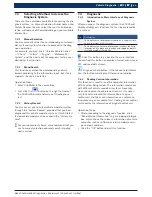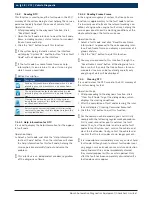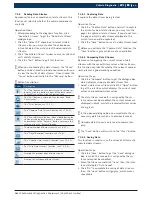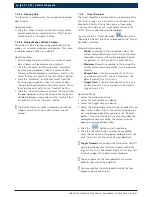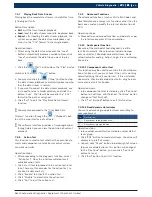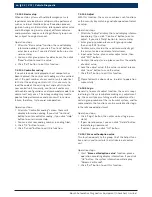
Bosch Automotive Diagnostics Equipment (Shenzhen) Limited
Safety instructions | ��� | 7
��� | 7
| 7
en
�.1.2
High voltages in hybrid vehicles and electric ve-
hicles as well as their high-voltage components
If high-voltage components or high-voltage
wires are inexpertly handled, there is a risk of
fatal injury from high voltages and the possib-
le transmission of current through the body.
¶
Deenergization is only to be performed by
a qualified electrician, a qualified electri-
cian for specific tasks (hybrid) or a power
systems engineer.
¶
Work on vehicles with high-voltage compo-
nents is only ever to be performed in a safe,
deenergized condition by persons with the
minimum qualification "Trained to perform
electrical work".
¶
Even after deactivating the high-voltage
vehicle electrical system, the high-voltage
battery may still be live.
¶
Operating condition cannot be established
from any running noise, as the electric ma-
chine is silent when stationary.
¶
In gear positions "P" and "N" the engine or
electric motor may start spontaneously depen-
ding on the charge of the high-voltage battery.
Safety measures:
¶
Never open or damage high-voltage batteries.
¶
On accident vehicles, never touch high-voltage com-
ponents or exposed high-voltage wires before deacti-
vating the high-voltage vehicle electrical system.
¶
Avoid contact with any high-voltage components
and high-voltage wires (orange sheathing) when in
operation.
¶
Secure against unauthorized renewed start-up
(e.g. by means of a padlock).
¶
Always wait at least 10 seconds after deactivating
the high-voltage system.
¶
Visually inspect the high-voltage components and
high-voltage wires for damage. The power systems
engineer responsible should always be immediate-
ly notified of any irregularities, doubts or defects
found.
$
High-voltage components must never exhibit signs
of external damage.
$
The insulation of the high-voltage wiring must be
intact and undamaged.
$
Watch out for any abnormal deformation of the
high-voltage wiring.
�.2
Danger of acid burning
When exhaust gas measurements are taken,
the
sampling hoses
which are used release a
highly caustic gas (hydrogen fluoride) that can
cause acid burning in the respiratory system
when heated to temperatures in excess of
250 °C (482 °F) or in the event of fire.
Rules of conduct:
¶
Consult a doctor immediately after inhaling!
¶
Always wear gloves made of neoprene or PVC when
removing residues left after a fire.
¶
Neutralize any residues left after a fire with a cal-
cium hydroxide solution. This produces non-toxic
calcium fluoride, which can be washed away.
Acids and alkalis
can cause severe burning on
unprotected skin. Hydrogen fluoride in combi-
nation with moisture (water) forms hydroflu-
oric acid. The
condensate
, which accumulates
in the sampling hose and in the condensate
container likewise contains acid.
Rules of conduct:
¶
When replacing the O2 measuring sensor, bear in
mind that it contains alkali.
¶
When replacing the NO measuring sensor, bear in
mind that it contains acid.
¶
Rinse any affected parts of the skin immediately in
water, then consult a doctor!
¶
NO and O2 measuring sensors are hazardous waste
and must be disposed of separately. Your Bosch spe-
cialist equipper can dispose of sensors in the proper
manner.
If liquid crystal escapes from a damaged
liquid
crystal display
, it is imperative to avoid direct
skin contact, inhalation and swallowing.
Rules of conduct:
¶
If you have inhaled or swallowed liquid crystal, con-
sult a doctor immediately!
¶
Wash the skin and clothing thoroughly with soap and
water if it has come into contact with liquid crystal.
If fluid (electrolyte) escapes from
batteries
and rechargeable batteries
, avoid getting it on
your skin or in your eyes.
Rules of conduct:
¶
If contact with skin or eyes happens nevertheless,
wash the affected parts immediately with clean wa-
ter and then consult a doctor.
Summary of Contents for KT400
Page 1: ...VCI User Manual ...
Page 2: ......

















